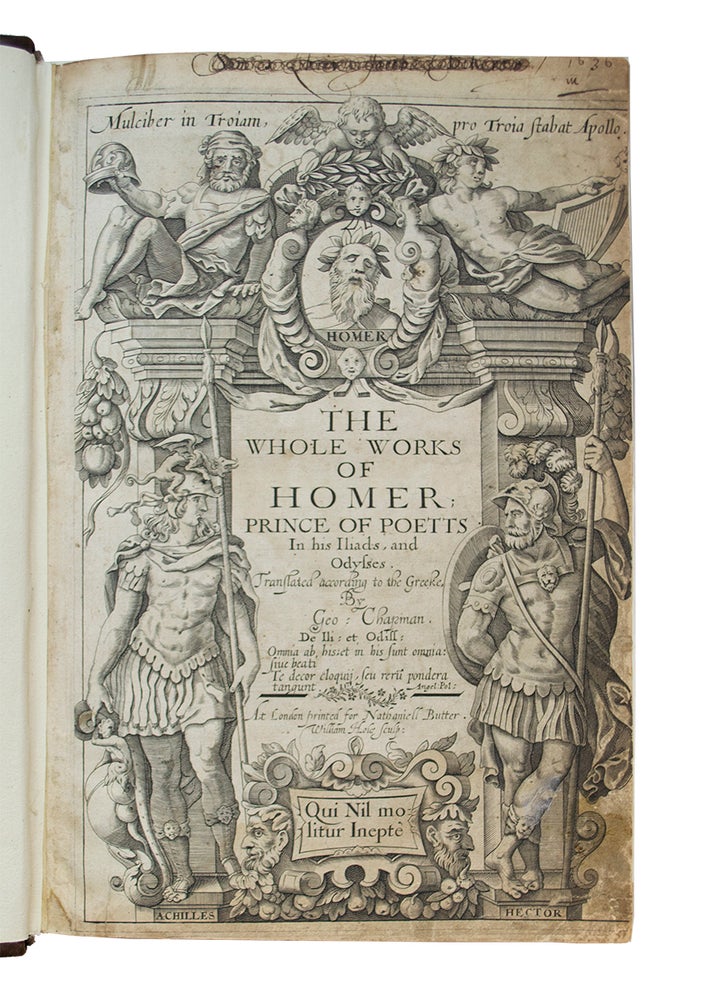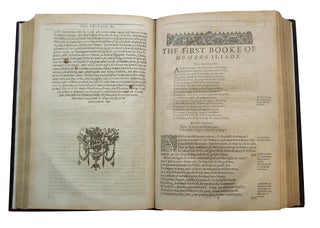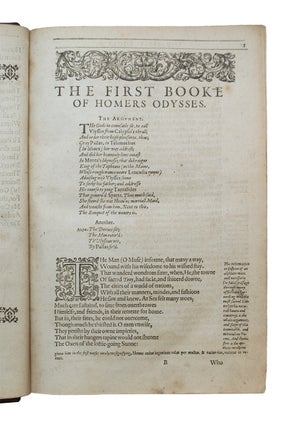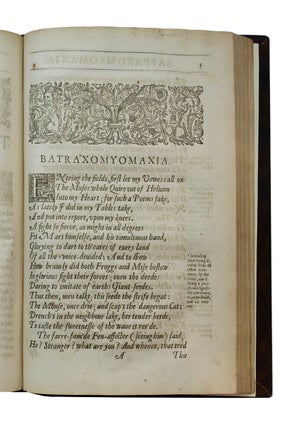Chapman’s Celebrated Translation of Homer, The First Collected Edition
Whole Works of Homer; Prince of Poetts. In his Iliads, and Odysses. Translated according to the Greeke, By Geo: Chapman. [Bound with] Batrachomyomachia.
London: Printed for Nathaniell Butter, 1640.
. The Whole Works of Homer; Prince of Poetts. In his Iliads, and Odysses. Translated according to the Greeke, By Geo: Chapman. [Bound with] Batrachomyomachia. London: Printed for Nathaniell Butter, 1640.
Full Description:
HOMER. CHAPMAN, George, [translator]. The Whole Works of Homer; Prince of Poetts. In his Iliads, and Odysses. Translated according to the Greeke, By Geo: Chapman. [Bound with] Batrachomyomachia. London: Printed for Nathaniell Butter, [n.d.c.a. 1616- 1640].
First collected edition of Chapman’s celebrated translation of Homer. Second issue of Iliad with “HOMER'S” in recto headlines and zig-zag headpieces. But with first issue of Odysses with the uncancelled leaf Aa5 with the period after "Poet." and the Portrait of Chapman on the verso of the engraved general title-page. The first issue which was published in 1616 was a reissue of both the twenty-four books of the Iliad of ca. 1611, and the twenty-four books of the Odyssey of ca. 1615. The last 12 books of the Odyssey are printed here for the first time. This is also the first time these works were put together with the Batrachomyomachia, which also does not have a separate tile page. " Small folio (10 5/8 x 7 inches; 270 x 180 mm). In this copy, After the engraved title and engraved dedication, the Odysses is bound first, then the Iliad, and finally the Batrachomyomachia which is not called for in this edition. [4, engraved general title and engraved dedication to Henry, prince of Wales], [Odysses}: [20], 341, [1], [8], [2 blank]; [Iliad]: [8], 193, [1, blank], 195-349, 352-[378]; [Batrachomyomachia] [8], 143, 148-179, [1, blank], 201-207, [1, blank], [4] pp. This copy of Iliad contains the genuine Gg8 blank, but bound without A6 "Faults escaped." Odysses and Iliad bound without all other blanks, but the missing blanks are supplied with later blanks.
Engraved architectural title by William Hole with bust of Homer at head and full-length figures of Achilles and Hector as supporters, engraved portrait of Chapman on verso of title, engraved dedication to the memory of Prince Henry, and with a facsimile engraved title to the Odyssey The original engraved title for the Odyssey in this collected work is generally not called for. According to Pforzheimer, "the separate engraved titles generally do not occur".
Full modern brown calf. Some mild soiling throughout. General title with some reinforcement to verso. Previous owner’s old ink notes dated 1636 to top of general title, and since scratched out. General title trimmed close at fore-edge. Overall a very good copy.
According to Pforzheimer: "Some remainder copies {of the Iliad 1611] were bound with the Odysses [1615] with a [an engraved] general-title The Whole Works [1616], a memorial engraving to Prince Henry, and, sometimes a portrait of Chapman prefixed. About 1640, apparently, copies of the present edition of the Iliads ran out and it was reprinted by Thomas Harper, anonymously. That edition was probably never issued separately but it may be easily distinguished from the present, through a paginary reprint, by the frequent use of a zig-zag headpiece and the fact that in it 'v' is used medially." (Pforzheimer 169). Also according to Pforzheimer, in regards to the Batrachomyomachia, "Copies sometime occur bound with the Iliads and Odyssey with a general-title The Whole Works. Such copies apparently always have the later (c.1640) printing of the Iliads but not all copies in which the latter occurs also contain the present." (Pforzheimer 165).
“Of Chapman’s translations, the most famous, not least because of a much-quoted sonnet by John Keats, are Homeric. Seven Books of the Iliad (1598) and Achilles’ Shield (1598) announced the beginning of what Chapman called ‘The Worke that I was borne to doe’” (The Cambridge Guide to Literature in English).
“The first instalment towards the complete translation of Homer was published in 1598, with the title ‘Seaven Bookes of the Iliades of Homere, Prince of Poets...’ It...comprises the first, second, and seventh to eleventh books inclusive...Later in 1598 Chapman published ‘Achilles Shield. Translated as the other seven Bookes of Homer, out of his eighteenth booke of Iliades’, 4to...Some years elapsed before the publication of ‘Homer, Prince of Poets: translated according to the Greeke in twelve Bookes of his Iliads,’ fol., which bears no date on the title-page, but was certainly not issued before 1609...On 8 April 1611 the complete translation of the ‘Iliad’ was entered on the Stationers’ register. The book was published (doubtless in the same year) under the title ‘The Iliads of Homer, Prince of Poets. Never before in any language truely translated. With a Comment upon some of his chiefe places,’ n. d., fol. In this edition Chapman gave a fresh translation of books i. and ii. (down to the catalogue of the ships)...After completing the translation of the ‘Iliad’ he set himself to translate the ‘Odyssey.’ On 2 Nov. 1614 there is an entry in the Stationers’ register to Nathaniel Butter of ‘Twenty-four Bookes of Homer's Odisses by George Chapman.’ The first twelve books had been previously published, but few copies of this separate impression are found. When the translation was completed the last twelve books were united with the previous impression of the first twelve...Finally the translations of the ‘Iliad’ and ‘Odyssey’ were united in one folio volume, and issued under the title of ‘The Whole Works of Homer, Prince of Poets, in his Iliads and Odysses’...At length, circ. 1624, Chapman concluded his Homeric labours by issuing ‘The Crowne of all Homer’s Workes, Batrachomyomachia or the Battaile of Frogs and Mise. His Hymn’s and Epigrams’... Chapman’s Homer is one of the great achievements of the Elizabethan age, a monument of skill and devotion. The mistranslations are many and grievous, and it is clear that Chapman’s knowledge of Greek was not profound; but through the whole work there breathes a spirit of sleepless energy that amply atones for all crudities and conceits. Among Chapman’s contemporaries the translation was received with applause...Pope acknowledges the merits of his predecessor‘s labours; and Dr. Johnson affirms that Pope never translated any passage of Homer without consulting Chapman’s version. Coleridge said that Chapman's Homer was as truly an original poem as the ‘Faerie Queene;’ Lamb was a fervid admirer of the rough old translation; and Keats has a noble sonnet ‘On first looking into Chapman's Homer’” (D.N.B.).
ESTC S119225. Grolier, Langland to Wither, 35 and 36. Lowndes, p. 1099. Pforzheimer 165. Pforzheimer 169. Pforzheimer 170. STC 13624.5.
HBS 68849.
$22,500.
Price: $22,500.00
Item #68849





